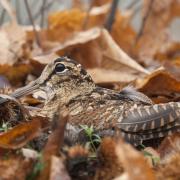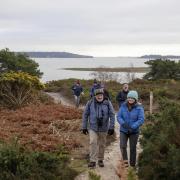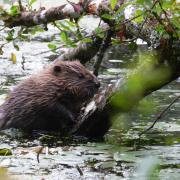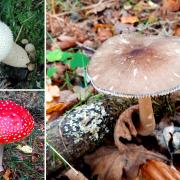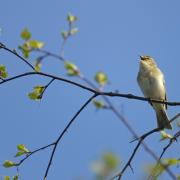The Posy Tree and the Remedy Oak are just two of the natural treasures that feature in a new book on Dorset�„�s historic trees, as Hester Lacey discovers
The Posy Tree and the Remedy Oak are just two of the natural treasures that feature in a new book on Dorset�s historic trees, as Hester Lacey discovers
No one can now be sure exactly when the plague came to Mapperton, but when it arrived the villagers were struck down with terrifying swiftness. As many as 80 people in this tiny community died, and the survivors were turned away when they attempted to bury their dead in Netherbury churchyard, the nearest consecrated ground. The trudge to Netherbury and back again took the villagers past the Mapperton Posy Tree, a huge sycamore which they had hung with posies of sweet-smelling herbs, in the vain hope that fragrant rosemary and lavender would protect them against contagion. This sycamore, which died only recently, still stands today; Zenobia Venner from Bridport would like to see a memorial placed by the tree’s sturdy remains. “The story is so poignant,” she says. “It says so much about human nature, both stoicism and cruelty.”
Zenobia’s poem about the Posy Tree, alongside the tree’s story, is published in The Great Trees of Dorset, a new book co-written by Emma Brawn, Dorset Wildlife Trust’s Greenwood Tree Officer. The Dorset Greenwood Tree Project aims to protect the county’s veteran trees – and also to celebrate them. Everyone relates to trees, says Emma. “They are so big, they have that wow factor, we climb them as children, and we’ve always used them for wood and charcoal. I don’t know of anyone who doesn’t like trees!”
“In every county there is a king or queen tree and the Remedy Oak is ours”
The new book highlights some of Dorset’s most magnificent specimens, some of which have survived since Roman times. They have served as boundaries, meeting places and ceremonial markers and have provided building materials and food for centuries. Emma’s own favourite is an enormous yew tree with a 26-metre canopy, which stands on Bulbarrow. Yews are particularly long-lived, as they regenerate by self-layering. “This brilliant, open-grown tree must pre-date Christianity,” says Emma. “Yews are usually found in churchyards and are managed, so it’s particularly nice to find one that has been left to its own devices.”
The Great Trees of Dorset also features the ancient avenue of lime trees at Parnham House near Beaminster. Two local war heroes are associated with Parnham. William Rhodes-Moorhouse was the first airman to be awarded the Victoria Cross, which he received posthumously in 1915 for his bravery in the First World War, and his grave at the family home is surrounded by the lime trees. His son, also called William, was less than a year old when his father died, and also gave his life for his country; he was shot down in the Battle of Britain in 1940 and his ashes were scattered alongside his father’s grave. RAF pilots still dip their wings as a mark of respect when passing overhead.
Emma has found that it can be difficult to sift facts from legend for some of Dorset’s most venerable trees. In the 16th century King Edward VI was supposed to have sat beneath the Remedy Oak in Woodlands, east Dorset, and touched people to cure the ‘King’s Evil’, a form of tuberculosis called scrofula; the royal touch was alleged to cure various diseases. “There’s no historical evidence that this actually happened,” says Emma. “But King Edward VI did stay near Woodlands, and it’s possible that he met his colleagues for hunting at a place called Remedy Gate, at the convergence of four or five roads. The gate is long gone, but the tree is still there, even though it’s now half-hollow and held up by cables. In every county there is a king or queen tree and this is ours.”
Another great Dorset oak is Judge Wyndham’s Oak in the village of Silton, just north of Gillingham. Named after Sir Hugh Wyndham, who lived at Silton Manor in the 17th century, the story goes that he would rest from his work as a judge under this favourite tree and had a seat placed there. Following the restoration of Charles II, Sir Hugh temporarily lost his job and even went to the Tower of London, but was later exonerated and knighted by the king.
Even in more urban environments, trees are part of Dorset’s identity. There can be few visitors to Poole Park who haven’t spotted the Corsican pine with its horizontal branches that allow for some exciting clambering and many will have photographs of their children (or themselves!) perched up in the tree. The Corsican pine was deemed worthy of inclusion in the book as it is such a local landmark. “It could have been planted when the park was opened in 1890 or it might not be that old, but everybody in Poole knows it,” says Emma.
At the Mapperton Posy Tree villagers hung posies of sweet-smelling herbs, in the vain hope that fragrant rosemary and lavender would protect them against contagion
The black poplar, with its rough bark and dramatic crimson catkins, is one of Britain’s rarest native trees; it likes wet conditions and was once a common sight on flood plains. However, its numbers declined dramatically until only an estimated 2,500 remained in the 1990s. Since then, numbers have crept back up to around 9,000. One ancient specimen lived, until recently, in the grounds of White Mill at Sturminster Marshall; the tree died in 2008 but its remains are still in situ. “It is a gaunt monument to ages of history,” says Colin Cope, who lives at White Mill, which is owned by the National Trust. Luckily, Colin had the foresight to plant saplings from the tree shortly after he moved to the mill 14 years ago, and these flourished. Some have been donated to other National Trust properties and Colin hopes to move one to the site of the old tree, although this will be allowed to remain. “It is a haven for wildlife, including nuthatches, treecreepers, wrens and bracket fungus,” explains Colin. “As well as being an important habitat, it is part of the history of the mill.” He hopes to take further saplings from the young black poplar he planted in his garden back in the mid-90s. “The tree, which I estimated from its girth to be about 350 years old, will live on through its children.”
Trees have always been one of Colin’s passions, and he created a photo essay recording the original black poplar in all seasons; now an invaluable record of a lost treasure. “There is a great deal of emotion in our response to trees, and that response is age old,” he says. “They represent the seasons in a very clear way, from piles of leaves in autumn to the elation of seeing them come alive in the spring. I think we instinctively stop and look and listen to trees. If only they could speak!”
Some of Dorset’s veteran trees have shaded herds of deer in medieval parks, some were putting down roots when the first Queen Elizabeth came to the throne and are still flourishing in the reign of the second, and a few witnessed the arrival of the Normans. The stories of these precious living monuments are a fascinating record of a county’s natural treasures.
The Great Trees of Dorset, by Emma Brawn and Andrew Pollard, illustrated by Colin Varndell, �16.95 hardback/�9.95 paperback, available in local bookshops or direct from Dovecote Press, 01258 840549. All royalties go to Dorset Wildlife Trust. For more information about the DWT call 01305 264620 or visit www.dorsetwildlife.co.uk.









